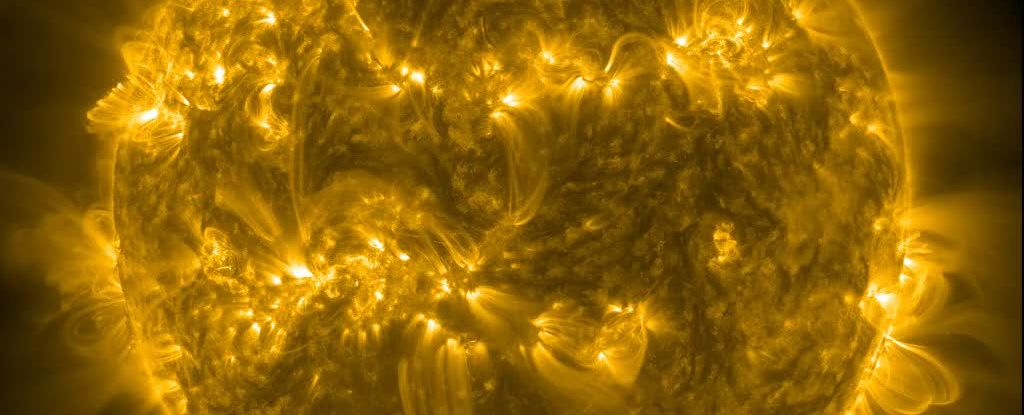The heartbeat of the Sun is a complex, multi-rhythmic affair, beating in different ways according to various periodicities. We don’t know what drives many of these solar heartbeats, but new findings revive and strengthen a link with the planets of the Solar System.
The Sun’s 11-year activity cycle – known as the Schwabe cycle – can be at least partially explained by a gravitational interaction between the Sun and Venus, Earth, and Jupiter, the new research suggests.
There are likely other driving factors at play, too. But the controversial planetary hypothesis, as it is known, is too neatly in sync with Schwabe cycles to be discounted, according to the team of researchers behind the new study, led by Frank Stefani, a physicist at the Helmholtz-Zentrum Dresden-Rossendorf lab in Germany.
The Sun’s activity, they have found, is mostly internally driven – but external influences may play a role too.
“You can think of it like a gigantic dynamo,” Stefani says.
“While this solar dynamo generates an approximately 11-year activity cycle in its own right, we think the planets’ influence then intervenes in the workings of this dynamo, repeatedly giving it a little push and thus forcing the unusually stable 11.07-year rhythm on the Sun.”
Roughly every 11 years or so, the Sun undergoes a dramatic series of transformations as its activity levels fluctuate. At solar minimum, it displays the least activity. Then, it gradually ramps up over the next few years. This manifests as an increase in sunspots, solar flares, and coronal mass ejections, until the peak known as solar maximum (we are close to solar maximum now).
Happy #SunDay! This week’s (totally nuts) space weather report includes:
· 52 M-class flares
· 9(!) X-class flares
· 45 coronal mass ejections
· 4(!) geomagnetic stormsThis video from NASA’s Solar Dynamics Observatory shows the week’s activity. Never a dull moment! pic.twitter.com/URlqT9WC9J
— NASA Sun & Space (@NASASun) May 19, 2024
At solar maximum, the Sun’s poles reverse their polarity, and activity subsides over several years to the next solar minimum before ramping up again to another maximum, and another pole reversal. This is the Schwabe cycle, and it repeats every 11 years or so, although there is a little bit of variation in the length of each cycle.
So where do the planets come in?
Well, every 11.07 years, around the time of solar minimum, Venus, Earth, and Jupiter form a line, briefly increasing their gravitational pull on the Sun in one direction. It’s only a weak effect, unlikely to impact the solar interior, but it could play a role in shepherding the solar cycles, synchronizing the internal dynamo to regular cycles.
Stefani and his colleagues have been investigating this potential link for some time, and now they believe they’ve found new evidence in its favor: giant vortical waves in the Sun called Rossby waves, only recently detected for the first time, similar to the Rossby waves on Earth that drive the atmospheric pressure system.
“We have now found the underlying physical mechanism,” Stefani says.
“We know how much energy is required to synchronize the dynamo, and we know that this energy can be transferred to the sun by so-called Rossby waves.
“The great thing is,” he continues, “we can now not only explain the Schwabe cycle and longer solar cycles but also the shorter Rieger cycles that we hadn’t even considered previously.”
The Rieger cycles are cycles of 150 to 160 days in flare activity on the Sun, and they have also been linked to the Rossby waves after extensive examination.
The researchers found that not only does the Venus-Earth-Jupiter alignment coincide with solar cycles, but the alignment of any two of the three planets has enough of a gravitational pull to activate Rossby waves. And it gets better – these alignments coincide with the Rieger cycles.
The team conducted mathematical modeling to verify their findings and found that they could replicate the Schwabe and Rieger cycles with their planetary alignments.
There was something else, too. Every 193 years or so, the strength of the solar magnetic field fluctuates, which the researchers believe is the Suess-de Vries cycle.
The Suess-de Vries cycle, they calculate, occurs when the 19.86-year periodic motion of the Sun around the Solar System’s center of gravity lines up with the Hale cycle – a double Schwabe cycle of 22.14 years. And this cycle also emerged in the team’s model.
Now, of course, the Sun is very big and very complex, so the planets – if they are involved – are only part of the picture. But the coincidences, the researchers say, are just too neat to be only coincidences.
“We’ll probably only be 100 percent certain when we have more data,” Stefani says.
“But the arguments in favor of a process clocked by the planets are now very strong.”
Woof. Well, at least one thing is clear: There’s still a lot of work yet to be done because remember, models are just rough approximations that can easily be wrong.
The team’s research has been published in Solar Physics.





